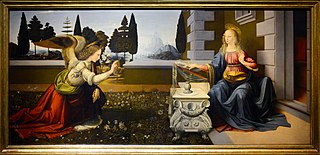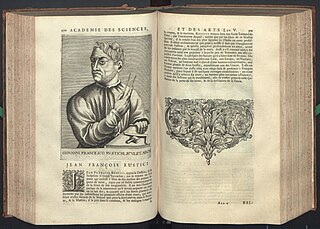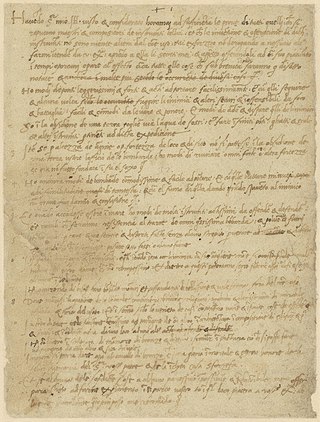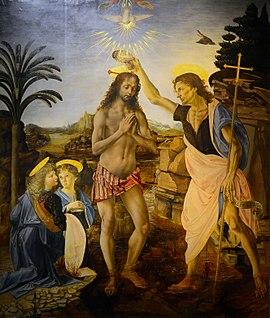
Leonardo di ser Piero da Vinci was an Italian polymath of the High Renaissance who was active as a painter, draughtsman, engineer, scientist, theorist, sculptor, and architect. While his fame initially rested on his achievements as a painter, he has also become known for his notebooks, in which he made drawings and notes on a variety of subjects, including anatomy, astronomy, botany, cartography, painting, and paleontology. Leonardo is widely regarded to have been a genius who epitomized the Renaissance humanist ideal, and his collective works comprise a contribution to later generations of artists matched only by that of his younger contemporary Michelangelo.

Andrea del Verrocchio was an Italian sculptor, painter and goldsmith who was a master of an important workshop in Florence.

The Palazzo Vecchio is the town hall of Florence, Italy. It overlooks the Piazza della Signoria, which holds a copy of Michelangelo's David statue, and the gallery of statues in the adjacent Loggia dei Lanzi.

Lorenzo di Credi was an Italian Renaissance painter and sculptor best known for his paintings of religious subjects. He is most famous for having worked in the studio of Andrea del Verrocchio at the same time as the young Leonardo da Vinci.

The Virgin of the Rocks, sometimes the Madonna of the Rocks, is the name of two paintings by the Italian Renaissance artist Leonardo da Vinci, of the same subject, with a composition which is identical except for several significant details. The version generally considered the prime version, the earlier of the two, is unrestored and hangs in the Louvre in Paris. The other, which was restored between 2008 and 2010, hangs in the National Gallery, London. The works are often known as the Louvre Virgin of the Rocks and London Virgin of the Rocks respectively. The paintings are both nearly 2 metres high and are painted in oils. Both were originally painted on wooden panels, but the Louvre version has been transferred to canvas.

The Annunciation is a painting widely attributed to the Italian Renaissance artist Leonardo da Vinci, dated to c. 1472–1476. Leonardo's earliest extant major work, it was completed in Florence while he was an apprentice in the studio of Andrea del Verrocchio. The painting was made using oil and tempera on a large poplar panel and depicts the Annunciation, a popular biblical subject in 15th-century Florence. Since 1867 it has been housed in the Uffizi in Florence, the city where it was created. Though the work has been criticized for inaccuracies in its composition, it is among the best-known portrayals of the Annunciation in Christian art.

Leonardo da Vinci was an Italian Renaissance painter and polymath who achieved legendary fame and iconic status within his own lifetime. His renown primarily rests upon his brilliant achievements as a painter, the Mona Lisa and The Last Supper, being two of the most famous artworks ever created, but also upon his diverse skills as a scientist and inventor. He became so highly valued during his lifetime that the King of France bore him home like a trophy of war, supported him in his old age and, according to legend, cradled his head as he died.
Francesco Botticini was an Italian painter of the Early Renaissance. He was born in Florence, where he remained active until his death in 1498. Although there are only few documented works by Botticini, a considerable corpus has been confidently attributed to him on the basis of style including a number of altarpieces, dozens of small-scale religious panels and a few portraits.

Giovan Francesco Rustici, or Giovanni Francesco Rustici, (1475–1554) was an Italian Renaissance painter and sculptor. He was born into a noble family of Florence, with an independent income. Rustici profited from study of the Medici sculpture in the garden at San Marco, and according to Giorgio Vasari, Lorenzo de' Medici placed him in the studio of Verrocchio, and that after Verrocchio's departure for Venice, he placed himself with Leonardo da Vinci, who had also trained in Verocchio's workshop. He shared lodgings with Leonardo while he was working on the bronze figures for the Florence Baptistry, for which he was ill paid and resolved, according to Vasari, not to work again on a public commission. Moreover, an echo of Leonardo's inspiration is unmistakable in the much-discussed and much-reviled wax bust of "Flora" in Berlin, ascribed to a circle of Leonardo and most probably to Rustici. At this time, Pomponius Gauricus, in De sculptura (1504), named him one of the principal sculptors of Tuscany, the peer of Benedetto da Maiano, Andrea Sansovino and Michelangelo. It may have been made in France, perhaps in the circle of Rustici, who entered Francis I's service in 1528.

The Italian polymath Leonardo da Vinci (1452–1519) left thousands of pages of writings and drawings, but rarely made any references to his personal life. The resulting uncertainty, combined with mythologized anecdotes from his lifetime, has resulted in much speculation and interest in Leonardo's personal life. Particularly, his personal relationships, philosophy, religion, vegetarianism, left-handedness and appearance.

Florentine painting or the Florentine School refers to artists in, from, or influenced by the naturalistic style developed in Florence in the 14th century, largely through the efforts of Giotto di Bondone, and in the 15th century the leading school of Western painting. Some of the best known painters of the earlier Florentine School are Fra Angelico, Botticelli, Filippo Lippi, the Ghirlandaio family, Masolino, and Masaccio.

Italian Renaissance painting is the painting of the period beginning in the late 13th century and flourishing from the early 15th to late 16th centuries, occurring in the Italian Peninsula, which was at that time divided into many political states, some independent but others controlled by external powers. The painters of Renaissance Italy, although often attached to particular courts and with loyalties to particular towns, nonetheless wandered the length and breadth of Italy, often occupying a diplomatic status and disseminating artistic and philosophical ideas.

This article about the development of themes in Italian Renaissance painting is an extension to the article Italian Renaissance painting, for which it provides additional pictures with commentary. The works encompassed are from Giotto in the early 14th century to Michelangelo's Last Judgement of the 1530s.

Andrea del Sarto was an Italian painter from Florence, whose career flourished during the High Renaissance and early Mannerism. He was known as an outstanding fresco decorator, painter of altar-pieces, portraitist, draughtsman, and colorist. Although highly regarded during his lifetime as an artist senza errori, his renown was eclipsed after his death by that of his contemporaries Leonardo da Vinci, Michelangelo, and Raphael.

The Adoration of the Shepherds is a painting by the Italian Renaissance painter Lorenzo di Credi, dating to about 1510. It is displayed in the Uffizi Gallery of Florence.

The Leonardeschi were the large group of artists who worked in the studio of, or under the influence of, Leonardo da Vinci. They were artists of Italian Renaissance painting, although his influence extended to many countries within Europe.

The Piazza Madonna is a tempera on panel painting, dating to 1474-1486 and held in Pistoia Cathedral.

The Adoration of the Kings is a small oil painting on panel of c. 1500 by Bramantino in the National Gallery, London. In it the Holy Family and the Magi are, unusually, joined by an adult John the Baptist, whose Baptism of Christ was celebrated on the same day as Epiphany in the liturgical calendar. At 56.8 cm (22.4 in) × 55 cm (22 in), it was probably commissioned for private use by an individual rather than for placing in a church, but nothing is known about its early history. The panel entered the National Gallery in 1916 as part of the Layard Bequest.

Leonardo is a historical drama television series created by Frank Spotnitz and Steve Thompson. The series was produced by Italian Lux Vide in collaboration with Rai Fiction, Sony Pictures Entertainment, with Frank Spotnitz's Big Light Productions and Freddie Highmore's Alfresco Pictures in association with France Télévisions and RTVE.


















